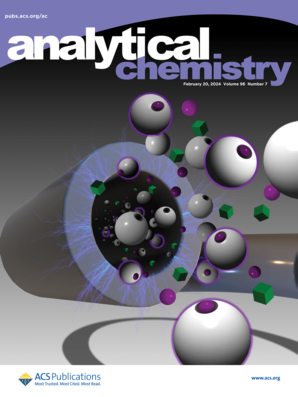AIE-Active Probe for Unveiling the Role of Protein Sulfenylation In Vivo: Specific Imaging and Therapeutic Insights.
IF 6.7
1区 化学
Q1 CHEMISTRY, ANALYTICAL
引用次数: 0
Abstract
Protein sulfenylation (protein-SOH) is a central oxidation product of protein post-translational modification (PTM) that is crucial for signal transduction and cell behavior. However, the natural properties of protein-SOH, especially its low responsiveness and dynamic reversibility, pose a great challenge to the development of chemical probes to visualize protein-SOH in vivo. Here, we report an activated aggregation-induced emission (AIE) probe for specifically lighting-up protein-SOH in vivo. The AIE-active probe reacts with protein-SOH by nucleophilic substitution and exhibits intense fluorescence due to the restriction of intramolecular motion. The uniqueness of this probe ensures that fluorescence is only lighted up by protein-SOH, avoiding interference from small-molecule active substances and nonspecific adsorption of proteins. The significant increase of protein-SOH in atherosclerotic mice is detected by the AIE probe, and the level of protein-SOH positively correlates with atherosclerosis progression. Significantly, we find that specific binding of protein-SOH by this probe can inhibit plaque development, making it a promising therapeutic target. This study enables real-time imaging of protein oxidation modification in vivo, opening up a universal chemical tool for further elucidation of PTM and its role in signal transduction.揭示体内蛋白质亚砜化作用的aie活性探针:特定成像和治疗见解。
蛋白质亚砜化(Protein - soh)是蛋白质翻译后修饰(PTM)的中心氧化产物,对信号转导和细胞行为至关重要。然而,蛋白质- soh的天然性质,特别是其低响应性和动态可逆性,给化学探针在体内可视化蛋白质- soh带来了很大的挑战。在这里,我们报道了一种激活的聚集诱导发射(AIE)探针,用于特异性点亮体内的soh蛋白。aie活性探针通过亲核取代与蛋白- soh反应,由于分子内运动受限而表现出强烈的荧光。该探针的独特性确保了荧光只被蛋白质- soh点亮,避免了小分子活性物质的干扰和蛋白质的非特异性吸附。AIE探针检测到动脉粥样硬化小鼠中蛋白- soh显著升高,蛋白- soh水平与动脉粥样硬化进展呈正相关。值得注意的是,我们发现该探针特异性结合蛋白- soh可以抑制斑块的发展,使其成为一个有希望的治疗靶点。本研究实现了体内蛋白质氧化修饰的实时成像,为进一步阐明PTM及其在信号转导中的作用开辟了一种通用的化学工具。
本文章由计算机程序翻译,如有差异,请以英文原文为准。
求助全文
约1分钟内获得全文
求助全文
来源期刊

Analytical Chemistry
化学-分析化学
CiteScore
12.10
自引率
12.20%
发文量
1949
审稿时长
1.4 months
期刊介绍:
Analytical Chemistry, a peer-reviewed research journal, focuses on disseminating new and original knowledge across all branches of analytical chemistry. Fundamental articles may explore general principles of chemical measurement science and need not directly address existing or potential analytical methodology. They can be entirely theoretical or report experimental results. Contributions may cover various phases of analytical operations, including sampling, bioanalysis, electrochemistry, mass spectrometry, microscale and nanoscale systems, environmental analysis, separations, spectroscopy, chemical reactions and selectivity, instrumentation, imaging, surface analysis, and data processing. Papers discussing known analytical methods should present a significant, original application of the method, a notable improvement, or results on an important analyte.
 求助内容:
求助内容: 应助结果提醒方式:
应助结果提醒方式:


